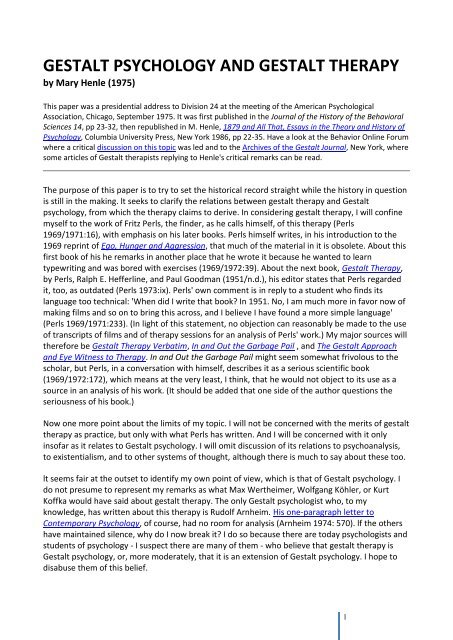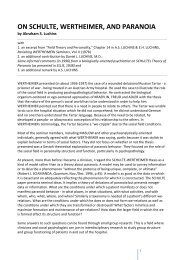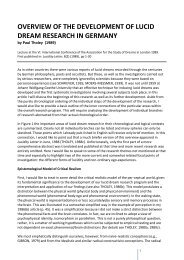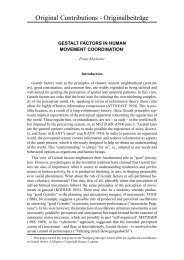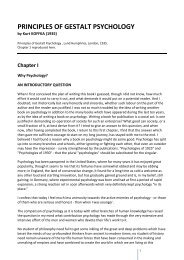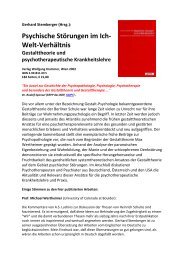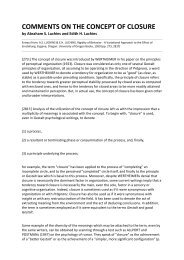Mary HENLE - Society for Gestalt Theory and its Applications (GTA)
Mary HENLE - Society for Gestalt Theory and its Applications (GTA)
Mary HENLE - Society for Gestalt Theory and its Applications (GTA)
- No tags were found...
Create successful ePaper yourself
Turn your PDF publications into a flip-book with our unique Google optimized e-Paper software.
I was astonished to read the statement of Perts' biographer, Martin Shepard (1975: 198) , thattraditional <strong>Gestalt</strong>ists claim him. Certainly Arnheim does not claim him when he writes, 'I can seeMax Wertheimer fly into one of his magnificent rages, had he lived to see one of the moreinfluential tracts of the therapeutic group in question dedicated to him as though he were thefather of it all' (1974:570). Perls himself is at times clearer than his biographer about his relation to<strong>Gestalt</strong> psychology. 'The academic <strong>Gestalt</strong>ists of course never accepted me,' he wrote. 'I certainlywas not a pure <strong>Gestalt</strong>ist' (1969/1972:62). He adm<strong>its</strong> not having read any of their textbooks, onlysome papers of Kurt Lewin, Wertheimer, <strong>and</strong> Köhler (ibid). Nevertheless, he claims that hisperspective comes 'from a science which is neatly tucked away in our colleges; it comes from anapproach called <strong>Gestalt</strong> psychology' (1969/1972:61). He continues by saying that he admired a lotof the work of the <strong>Gestalt</strong> psychologists, 'especially the early work of Kurt Lewin' (1969/1972:62).First may I state the hard facts about his relation to <strong>Gestalt</strong> psychology. Perls tells us that he wasKurt Goldstein's assistant in Frankfurt in 1926 (1969/1972:4); he apparently also heard lectures byAdhemar Gelb (1969/1972:62). In this connection it may be pointed out that, while Goldstein didnot view most of his differences with <strong>Gestalt</strong> psychology as 'insurmountable discrepancies,' he didnot regard himself as a <strong>Gestalt</strong> psychologist but, rather, a holist or organismic psychologist.And now the issues. <strong>Gestalt</strong> psychology arose in Germany around 1910 out of what was called theCrisis of Science. Not only science, but academic knowledge in general, was losing the confidenceof more <strong>and</strong> more people, intellectuals included, because it could not deal with major humanconcerns, <strong>for</strong> example such problems as value or meaning, <strong>and</strong>, indeed, seemed uninterested inthem. In psychology, in opposition to the traditional experimental psychology, there arose aspeculative psychology whose goal was to underst<strong>and</strong> rather than to explain. Let the experimentalpsychologists find causal laws in their narrow domain, so the argument went. The really centralhuman issues must be dealt with outside the natural science tradition, in the tradition calledGeisteswissenschaft - a word <strong>for</strong> which we have no contemporary English counterpart, although itis <strong>its</strong>elf a translation of John Stuart Mill's expression, the mental <strong>and</strong> moral sciences.<strong>Gestalt</strong> psychologists did not accept this split within their discipline. They believed that theshortcomings of the traditional psychology arose, not because it was scientific, but because itmisconceived science. Scientific analysis, it was simply taken <strong>for</strong> granted at the time, wasatomistic. The model of the traditional psychology was an atomistic, mechanistic conception of thephysical sciences. <strong>Gestalt</strong> psychologists held that scientific analysis need not be atomistic. Usingphysical field theory as their model, they worked to develop a nonatomistic psychology within thetradition of natural science.Here is a first issue: natural science vs. Geisteswissenschaft, explaining vs. underst<strong>and</strong>ing. <strong>Gestalt</strong>psychology is clearly an explanatory natural science. What about gestalt therapy?Perls equally clearly supports an underst<strong>and</strong>ing psychology. Here are a few quotations:In scientific explanation, you usually go around <strong>and</strong> around <strong>and</strong> never touch the heart of the matter. (1969/1971:16)Aboutism is science, description, gossiping, avoidance of involvement, round <strong>and</strong> round the mulberry bush.(1969/1972:210)If we explain, interpret, this might be a very interesting intellectual game, but it's a dummy activity, <strong>and</strong> a dummyactivity is worse than doing nothing. If you do nothing, at least you know you do nothing. (1969/1971:70)I reject any explanatoriness as being a means of intellectualizing <strong>and</strong> preventing underst<strong>and</strong>ing. (1969/1972:169)2
This theme appears again <strong>and</strong> again in Perls' books.It might be supposed that he is talking here about technique, about avoiding interpretations intherapy. He is, of course, also talking about technique, but some of these quotations go muchfarther. There are other indications of Perls' rejection of scientific psychology. He regards hisapproach as existential <strong>and</strong> asserts: 'Existentialism wants to do away with concepts, <strong>and</strong> to workon the awareness principle, on phenomenology' (1969/1971:16). Again, his approach is describedas 'an ontic orientation where Dasein - the fact <strong>and</strong> means of our existence - manifests <strong>its</strong>elf,underst<strong>and</strong>able without explanatoriness; a way to see the world not through the bias of anyconcept' (1969/1972:61).Science, of course, is conceptual.In other connections, too, we see that Perls is operating outside the sphere of natural science. Thestructure of our lifescript, he says, is often called karma or fate (1973:120), by no means ascientific concept. Nor is satori (1970/1973.-13), nor 'mini-satori' (1973:131). Hints of vitalismappear in his writing. For example, Perls identifies his 'excitement' with Henri Bergson's élan vital(1970/1973:38). Again, he describes a tree whose roots grow in the direction of fertilizer <strong>and</strong> shiftif the fertilizer is shifted; he comments: 'We cannot possibly explain / By calling this 'mechanics''(1969/ 1972:28). In this connection, it is interesting to recall a remark by Koffka, 'I believe that themechanist has no better friend than the vitalist' (1938:226). Perls, unable to accountmechanistically <strong>for</strong> the phenomena of growth <strong>and</strong> regulation, resorts to vitalism. But science, asthe <strong>Gestalt</strong> psychologists in particular have pointed out, need not be mechanistic; thus the failureof mechanism does not exclude a scientific approach.In short, we find that <strong>Gestalt</strong> psychology is a natural science, while Perls - whether he knows it ornot - st<strong>and</strong>s in the Tradition of Geisteswissenschaft. It would be interesting to know what sciencehe has in mind when he modestly acknowledges, 'The crazy Fritz Perls is becoming one of theheroes in the history of science, as someone called me at the convention, <strong>and</strong> it is happening inmy lifetime' (1969/1972:265). <strong>Gestalt</strong> psychology is an explanatory science, while Perls choosesunderst<strong>and</strong>ing psychology. The difference is so crucial that I could conclude at this point that thereis no substantive relation between <strong>Gestalt</strong> Psychology ind gestalt therapy. Other important issuesremain, however.A related point is the anti-intellectualism that pervades gestalt therapy. 'Intellect,' says Perls, 'isthe whore of intelligence - the computer, the fitting game' (1969/1971:24). 'It might sound a bitpeculiar,' he concedes, 'that I disesteem thinking, making it just a part of role-playing'(1969/1971:37). 'The intellect . . . [is] a drag on your life' 1969/1971:76). 'Each time you use thequestion why, you diminish in stature. You bother yourself with false, unnecessary in<strong>for</strong>mation'(ibid). I could multiply quotations. <strong>Gestalt</strong> psychologists, on the contrary, have the highest respect<strong>for</strong> disciplined thinking, one of whose finest achievements is science.Let us now consider the mind-body problem. <strong>Gestalt</strong> psychology has <strong>for</strong>mulated the hypothesis ofpsychophysical isomorphism, both as a position on the mind-body question <strong>and</strong> as a heuristic.Isomorhism starts from the prima facie dualism of mind <strong>and</strong> matter but hypothesizes that molarevents in experience are structurally identical to the corresponding molar physiological events inthe brain. This is a kind of parallelism, but more specific than mere parallelism; it is this specificitythat has made isomorphism a powerful heuristic. Parallelism of any kind is, of course, a dualistichypothesis.3
How does Perls st<strong>and</strong> on this issue? He dismisses the mind-body dichotomy as a superstition(1969/1972:8) <strong>and</strong> comes out <strong>for</strong> monism: we do not have a body, he maintains, 'we are a body,we are somebody' (1969/1971:6). 'Thoughts <strong>and</strong> actions are made of the same stuff' (1973:14).Again, 'If mental <strong>and</strong> physical activity are of the same order, we can observe both asmanifestations of the same thing: man's being' (1973:15). On the whole, he seems to adopt adouble aspect theory, though at times his <strong>for</strong>mulation sounds idealistic:Reality is nothing butThe sum of all awarenessAs you experience here <strong>and</strong> now. (1969/1972:30)'Philosophizing is a drag,' Perls asserts (ibid). Of course it is if you do it so badly. But the presentpoint is that, with regard to their positions on the relation of the mind <strong>and</strong> body, <strong>Gestalt</strong>psychology <strong>and</strong> gestalt therapy have nothing in common.'Figure/ground, unfinished situation <strong>and</strong> <strong>Gestalt</strong> are the terms which we have borrowed from<strong>Gestalt</strong> psychology,' say Perls, Hefferline, <strong>and</strong> Goodman (1951/n.d.:ix-x). lt is time to examine themeanings of these terms in the two contexts.For the meaning of <strong>Gestalt</strong>, I quote Köhler:In the German language ... the noun '<strong>Gestalt</strong>' has two meanings: besides the connotation of shape or <strong>for</strong>m as anattribtite of things, it has the meaning of a concrete entity per se, which has, or may have, a shape as one of <strong>its</strong>characteristics. Since Ehrenfels' time the emphasis has shifted from the Ehrenfels qualities to the facts of organization,<strong>and</strong> thus to the problem of specific entities in sensory fields. ( <strong>Gestalt</strong> Psychology, 1947:177-178)Perls' use of the term <strong>Gestalt</strong> is much vaguer. His attitude toward it he describes as an article offaith (1969/1972- 35). A gestalt is an essence, he says (1969/1972-63). Again, he describes it as'the irreducible phenomenon of all awareness' (1969/1972:30). Perls recognizes that a gestalt is aunit of experience, that 'as soon as you break up a gestalt, it is not a gestalt any more'(1969/1971:16). But he does not go any farther into the description of <strong>its</strong> properties. Neither Perls'<strong>Gestalt</strong> Manifesto (1969/1972:213) nor his old <strong>Gestalt</strong> Prayer has any relation to any knownmeaning of the word <strong>Gestalt</strong>.A segregated entity possesses figural characteristics: shape <strong>and</strong> the substantiality of a thing bycontrast with <strong>its</strong> background, which usually has no shape <strong>and</strong> is less compact. It owes <strong>its</strong> shape tothe one-sided function of the contour, which ordinarily belongs to the figure, but not to theground. There are other functional differences, too, between figure <strong>and</strong> ground. Althoughperceptual figures may be reversible under certain circumstances, this is not the rule.Edgar Rubin's terms "figure" <strong>and</strong> "ground" were eagerly adopted by Perls. For example, "Thedorminant need of the organism, at any time, becomes the <strong>for</strong>eground figure, <strong>and</strong> the other needsrecede, at least temporarily, into the background" (1973-8). lt may be that needs possess thecharacteristics of shaped figures, but if so, this must be shown, not simply assumed. (More likely, itis the need-object organization that should be subjected to such analysis; the goal, as end, iscomparable to the edge of a closed figure, as Köhler [1939:79] has pointed out.) Without anyanalysis, Perls seems simply to be using the distinction between figure <strong>and</strong> ground as equivalent tothat between important <strong>and</strong> unimportant. While the figure is important in the perceptual field, ithas <strong>its</strong> own specific properties that are lost in the equation. And why do you need figure-groundterminology to say that something is important?4
'To change a habit involves pulling that habit out of the background again <strong>and</strong> investing energy . . .to disintegrate or to reorganize the habit' (1969/1972:66). This time Perls apparently means -focus attention on the activity usually per<strong>for</strong>med automatically. I have no doubt that it is possibleto conceptualize an activity sequence in <strong>Gestalt</strong> terms, but Perls has not done it - he has merelyused the words. lf his expression is equivalent to Rubin's distinction, this remains to be shown.Perls asserts that ritual 'makes the gestalt clearer, makes, the figure st<strong>and</strong> out more sharply'(1973:29). The meaning is apparently once more that the special importance of something is beingemphasized. I need not repeat my remarks about importance. But what is the figure that is madeto st<strong>and</strong> out by a h<strong>and</strong>shake or a toast? Perhaps the h<strong>and</strong>shake emphasizes the beginning or theend of an encounter, but what is the structure of the encounter? The use of figure-groundterminology is no substitute <strong>for</strong> specifying the characteristics of a social event.At one point Perls tells us that he is bogged down in his writing <strong>and</strong> remarks, 'I would not be a<strong>Gestalt</strong>ist if I could not enter the experience of being bogged down with confidence that somefigure will emerge from the chaotic background' (1969/1972:37-38). What he means, it wouldseem, is that he is sure he will find something to say. Again, what is gained by speaking of figure?What is lost, I repeat, is the specific meaning of figure <strong>and</strong> ground. Incidentally, a chaoticbackground is hardly conducive to the segregation of a figure.Perls finds it important that figure <strong>and</strong> background be easily interchangeable. 'Otherwise we get adisturbance in the attention system-confusion, loss of being in touch, inability to concentrate <strong>and</strong>to get involved' (1969/1972:93). lt has been pointed out earlier that in perception reversiblefigures are the exception. From the context it appears the Perls means that, <strong>for</strong> optimalfunctioning, there must be an alternation between what he calls coping <strong>and</strong> withdrawal, theremust be flexibility of the personality, <strong>and</strong> the like; but what these have in common with figure <strong>and</strong>ground in the sense of Rubin <strong>and</strong> the <strong>Gestalt</strong> psychologists is never made clear.In all these examples, <strong>and</strong> many others that might be discussed, it seems to me that the figuregroundterminology is used so loosely by Perls that it conceals problems rather than clarifies them.Since <strong>Gestalt</strong> psychologists emphasize organization, let us turn to that problem. As Köhler puts it,organization 'refers to the fact that sensory fields have in a way their own social psychology'(1947:120). That is, certain un<strong>its</strong> or groups exist which are relatively segregated from theirenvironment: certain parts of, say, the visual field belong together <strong>and</strong> are segregated fromothers. Wertheimer investigated the factors that govern perceptual organization: similarity,proximity, good continuation, closure, etc.Of Wertheimers factors of orginization, the only one in which Perls shows any interest is closure<strong>and</strong> lack of closure. The latter term he uses interchangeably with 'unfinished situation' - atechnique, not a concept, derived from Lewin. Let us consider some examples of unclosed gestaltsas they are used in gestalt therapy.'Our life is basically practically nothing but an infinite number of unfinished situations-incompletegestalts.' writes Perls. 'No sooner have we finished one situation than another comes up'(1969/1971:15). The neurotic 'indivual somehow interrupts the ongoing processes of life <strong>and</strong>saddles himself with so many unfinished situations that he cannot satisfactorily get on with theprocess of living' (1973:23). These unfinished situations from the past compel him to repeat themin everyday life (1973:91). (Incidentally, Freud's repetition compulsion is here made a matter of5
unclosed gestalts without, so far as I can see, shedding any light on it.) If we find a certainplausibility, along with a disdain <strong>for</strong> specific analysis, in the treatment of unsatisfied needs asunclosed gestalts, this plausibility is lost in further examples. In the case of one patient, Perlsremarks, that he was unable in one session to 'achieve full closure, milk the symptom dry'(1969/1972: 139). War, with <strong>its</strong> frustrations, is apparently an incomplete gestalt; at any rate,peace is the possible closure (1969/1972:87).Here is a final example of the many Perls provides: 'We . . . have to fill in the holes in thepersonality to make the person whole <strong>and</strong> complete again' (1969/1971:2). I happen to believe thatthe phenomenal personality, like other percepts, can he conceptualized as an organized whole,though the theoretical problems involved are extraordinarily difficult <strong>and</strong> only the most primitivebeginnings have been made - not, by the way, by gestalt therapists. Until we can say somethingspecific about this organization, it does not add to our knowledge to say that 'the neurotic man ofour time' is an 'incomplete, insipid personality with holes' (Perls 1969/1972:294). As I haveindicated, in some of these instances there is a certain vague plausibility about Perls' use ofcomplete <strong>and</strong> incomplete situations, closed <strong>and</strong> unclosed gestalts. But vague plausibility is notenough <strong>for</strong> a theory of neurosis or therapy or personality - or of anything. lt is necessary to beclear about the specific characteristics of the structure we are calling neurosis or personality,about the nature of the processes involved, <strong>and</strong> the nature of the closure dem<strong>and</strong>ed by thatstructure. Such questions are never found in the material I am considering, <strong>and</strong> we are left with aterminology so vague as to defy any specific use. A concept loosely applied to a perceived figure,to a neurotic personality, <strong>and</strong> to war does not shed any specific light on any of these phenomena.For a theory, we must also be able to say in what ways the perceived figure, the personality, <strong>and</strong>the war are different, not merely stretch the same term to include them all.The following is a passage from Köhler on the extension of the concept of <strong>Gestalt</strong>:The concept '<strong>Gestalt</strong>' may be applied far beyond the lim<strong>its</strong> of sensory experience. According to the most generalfunctional definition of the term, the processes of learning, of recall, of striving, of emotional attitude, of thinking,acting, <strong>and</strong> so <strong>for</strong>th, may have to be included.... By no means is it believed, however, that any of those larger problemscan actually be solved by the application merely of general principles. On the contrary, whenever the principles seemto apply, the concrete task of research is only beginning; because we want to know in precisely what mannerprocesses distribute <strong>and</strong> regulate themselves in all specific instances. ( <strong>Gestalt</strong> Psychology, 1947:178-179).lt is this crucial step - the working out of the <strong>Gestalt</strong> concept in connection with specific problems -that Perls has omitted. He does have some things to say - at times, it seems, almost inadvertently -about how organization occurs, <strong>and</strong> it is interesting to compare these remarks, with the<strong>for</strong>rnulations of the <strong>Gestalt</strong> psychologists. The conditions of organization suggest to the <strong>Gestalt</strong>psychologist what processes must be responsible <strong>for</strong> them. In accordance with the principle ofisomorphism, the demonstrated relational properties of perception (<strong>and</strong> of other psychologicalphenomena which I will not discuss here) suggest corresponding physical interactions in thenervous system, particularly in the cerebral cortex. These interactions depend on the properties ofthe cortical events in relation to each other (Köhler 1940:55); <strong>and</strong> these properties, in turn, areultimately largely a consequence of the nature of the stimulation that starts the chain of eventsleading to perception.For Perls, interest, cathexis, motivation, or attention produces organization. This view appears inhis first book (1947/1969:53) <strong>and</strong> is more explicit in <strong>Gestalt</strong> Therapy. We read, 'The figure/ groundcontrast . . . is . . . the work of spontaneous attention <strong>and</strong> mounting excitement' (Perls, Hefferline,<strong>and</strong> Goodman 1951/n.d.:73). Again,''Objects' of sight <strong>and</strong> hearing exist by interest, confrontation,6
discrimination, practical concern' (1951/n.d.: 372n). What would seem to be a motor theory ofperception is, at times, assumed: 'The eyes <strong>and</strong> fingers cooperate in drawing outlines, so that theanimal learns to see more shapes <strong>and</strong> to differentiate objects in his field. By outlining onedifferentiates experience into objects' (1951/n.d.:312). In another place Perls suggests that 'westart with the impossible assumption that whatever we believe we see in another person or in theworld is nothing but a projection. Might be far out, but it's just unbelievable how much we project<strong>and</strong> how blind <strong>and</strong> deaf we are to what is really going on' (1969/1971:72). Although he does nothold with it completely, Perls seems to be saying that this assumption has something to it. Thestatement is less radical, but the meaning essentially unchanged, when he tells us that cathectedobjects become figure (1973:19). Once more, it is asserted that things-by which I assume hemeans phenomenal things - 'come about, more or less, by man's need <strong>for</strong> security'(1970/1973:20).It is difficult to discuss Perls' theory because we are not told on what the interest, attention, <strong>and</strong>cathexis are acting to produce percepts. lt is certainly not on organized entities, since they do theorganizing. Presumably, there<strong>for</strong>e, they are acting on sensory data. If this is the case, Perls'(partially implicit) theory is not only not <strong>Gestalt</strong> psychology; it is <strong>for</strong>mally similar to the theoriesthat <strong>Gestalt</strong> psychologists have criticized again <strong>and</strong> again, ever since Köhler's paper of 1913, 'OnUnnoticed Sensations <strong>and</strong> Errors of Judgment' (1913/1971). lndeed, Perls' theory, if it were spelledout, would seem to be very similar to those put <strong>for</strong>th by G. E. Müller <strong>and</strong> Eugenio Rignano in the1920s, both of which were criticized by Köhler. About such theories it may be said that neitherattention nor interest creates <strong>for</strong>m; rather, a <strong>for</strong>m must be perceived be<strong>for</strong>e it can be attended toor cathected. In both cases, the directional process presupposes the organization; the argument isthus circular. A similar problem arises if a motor theory is really meant: if visual organizationcomes from kinaesthesis, then that kinaesthetic organization remains to be explained. All thetheory has succeeded in doing has been to push the problem into another sensory modality.lt is not necessary, so far as I can see, that a theory of therapy include a theory of perception. Butif the author insists on such a theory, there are certain known pitfalls he would do well to avoid. Ifhe believes that his theory is a <strong>Gestalt</strong> theory, he would be well advised to look into what the<strong>Gestalt</strong> psychologists have to say.<strong>Gestalt</strong> psychology is most developed in perception <strong>and</strong> cognition, while gestalt therapy isconcerned with personality, psychopathology, <strong>and</strong> psychotherapy. Comparison of approaches tosuch different areas is often difficult. Nevertheless, in the present case, additional issues invitecomparison. As it happens, none of them is trivial.<strong>Gestalt</strong> psychology has, from <strong>its</strong> inception, been interested in value. Challenging the widely heldview of ethical relativism, the view that what is right <strong>and</strong> wrong changes with time <strong>and</strong> place, ithas tried to underst<strong>and</strong> values in terms of relations within happenings themselves. The value of anaction is seen as depending on <strong>its</strong> appropriateness to the dem<strong>and</strong>s of the given situation. Thus,<strong>Gestalt</strong> psychologists have held that values are not arbitrarily attached to objects or actions,depending on subjective evaluation or on the individual's history of rewards <strong>and</strong> punishments. Ananalogy of Wertheimer's will perhaps be helpful:Someone in adding makes seven plus seven equal fifteen. ... And he says, I call it good because I love the numberfifteen.... The determination of the fifteen is ... in violation of that which is dem<strong>and</strong>ed by the structure of the objectivesituation. If I prefer the fifteen in this case ... this is irrelevant to the fact that the fifteen is wrong. 1935:360-361)7
What about Perls? In Ego, Hunqer <strong>and</strong>Aggression, ethical relativism is simply taken <strong>for</strong> granted,<strong>and</strong> good <strong>and</strong> bad are derived from feelings of com<strong>for</strong>t <strong>and</strong> discom<strong>for</strong>t (1947/1969:59). The nextbook, <strong>Gestalt</strong> Therapy, describes two ingredients of moral evaluations: ' (a) On the one h<strong>and</strong>, theyare simply technical skills that one has learned, guesses as to what leads to success' <strong>and</strong> '(b) Onthe other h<strong>and</strong>, they are group-loyalties . . . : one acts in a certain way because it is the socialexpectation, including the expectation of one's <strong>for</strong>med personality' (Perls, Hefferline, <strong>and</strong>Goodman 1951/n.d.:424). Here values are obviously regarded as external to the events inquestion. They might just as well be reversed if the individual's personal history had been differentor if he belonged to a different group.The same relativism, more baldly <strong>and</strong> more cynically expressed, is to be found in <strong>Gestalt</strong> TherapyVerbatim: 'The whole idea of good <strong>and</strong> bad, right <strong>and</strong> wrong, is always a matter of boundary, ofwhich side of the fence I am on' (1969/1971:9). Perls distinguishes three kinds of philosophy: inaddition to existentialism, which includes gestalt therapy, we have already encountered aboutism,encompassing science, gossiping <strong>and</strong> other futile activities, <strong>and</strong> then there is shouldism ormoralism, in which we find topdog <strong>and</strong> underdog engaged in self-torture games (1969/1971:16-18). Shoulds are internalized external controls, <strong>and</strong> they interfere with the healthy functioning ofthe organism (1969/1971:20).It would be difficult to find a view of values farther from that of the <strong>Gestalt</strong> psychologists thanPerl's view. The <strong>Gestalt</strong> psychologists have shown that '"value-sitiuations fall under the category ofgestalt' (Köhler 1938:86). Perls has treated them without regard <strong>for</strong> this category, indeed withoutregard <strong>for</strong> values.A word about truth. Apart from calling it one of the fitting games, Perls says that 'by 'truth' I meannothing but the assertion that a statement we make f<strong>its</strong> the observable reality' (1970/ 1973:13).This conception is precisely the one that Wertheimer has shown to be inadequate. For the samestatement may, in one context, be true, in another false, in a third unintelligible. Nor doesWertheimer regard truth as a game: 'Science is rooted in the will to truth. With the will to truth <strong>its</strong>t<strong>and</strong>s or falls. Lower the st<strong>and</strong>ard even slightly <strong>and</strong> science becomes diseased at the core. Notonly science, but man' (1934:135).I have allready mentioned the relation between mechanism <strong>and</strong> vitalism. <strong>Gestalt</strong> psychology hasconsistently rejected both. Machine theories of the nervous system have been <strong>its</strong> particular target:<strong>Gestalt</strong> psychology has emphasized free dynamics within the lim<strong>its</strong> imposed by anatomicalconstraints. Perls, quite the contrary, refers to the organism as a machine (1969/1971:15), <strong>and</strong> tothe 'thinking system,' as he calls it, as a computer (1970/1973:28-29).I would now like to say a word about phenomenology as it figures in <strong>Gestalt</strong> psychology <strong>and</strong> ingestalt therapy. (I am using the term 'phenomenology' as psychologists generally do, to refer tothe unbiased description of the phenomenal world, not to refer to Edmund Husserl's theory ofintentionality.) For <strong>Gestalt</strong> psychology, phenomenology is a first step, a propaedeutic toexperimental research <strong>and</strong> to a science of functional relations that transcends phenomenology.Perls calls himself a phenomenologist (1969/1972:37)-, <strong>for</strong> him this method plays a different rolethan in <strong>Gestalt</strong> psychology. Phenomenology, he says, 'is the primary <strong>and</strong> indispensable steptowards knowing all there is to know' (1969/1972:69).I have by no means exhausted my material. For example, Perls' misuse of the equilibrium conceptmight be discussed. His underst<strong>and</strong>ing of heredity <strong>and</strong> of evolution might be culled from hiswritings <strong>and</strong> contrasted with that of <strong>Gestalt</strong> psychology. His view of person perception, like that of8
object perception, could be shown to differ from that of the <strong>Gestalt</strong> psychologists. His mostlyimplicit conception of the thinking process might be examined, <strong>and</strong> so on.From the material already discussed, it is not difficult to reach a conclucion. What Perls has donehas been to take a few terms from <strong>Gestalt</strong> psychology, stretch their meaning beyond recognition,mix them with notions-often unclear <strong>and</strong> often incompatibible - from the depth psychologies,existentialism, <strong>and</strong> common sense, <strong>and</strong> he has called the whole mixture gestalt therapy. His workhas no substantive relation to scientific <strong>Gestalt</strong> psychology. To use his own language, Fritz Perlshas done 'his thing'; whatever it is, it is not <strong>Gestalt</strong> psychology.9


